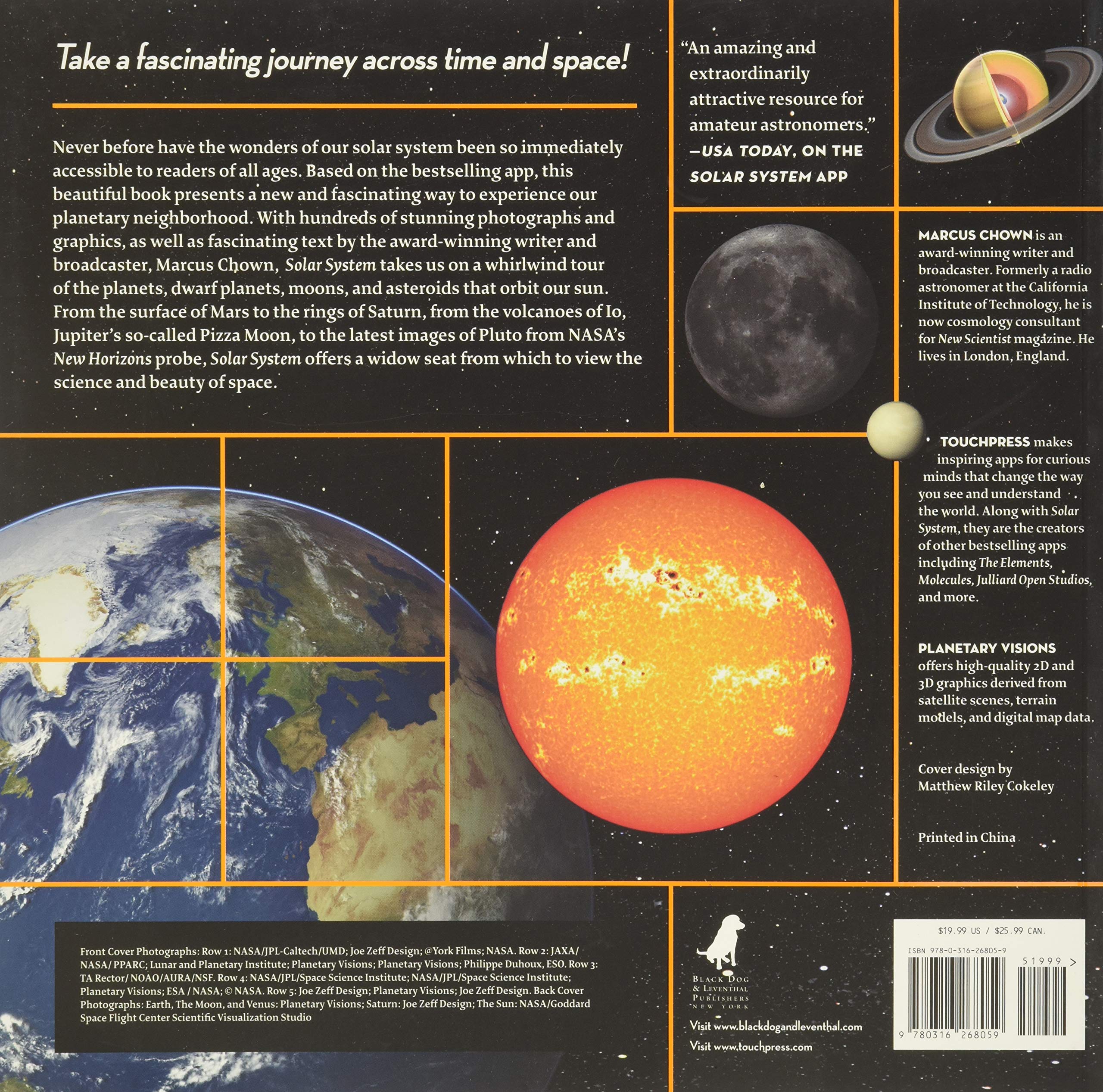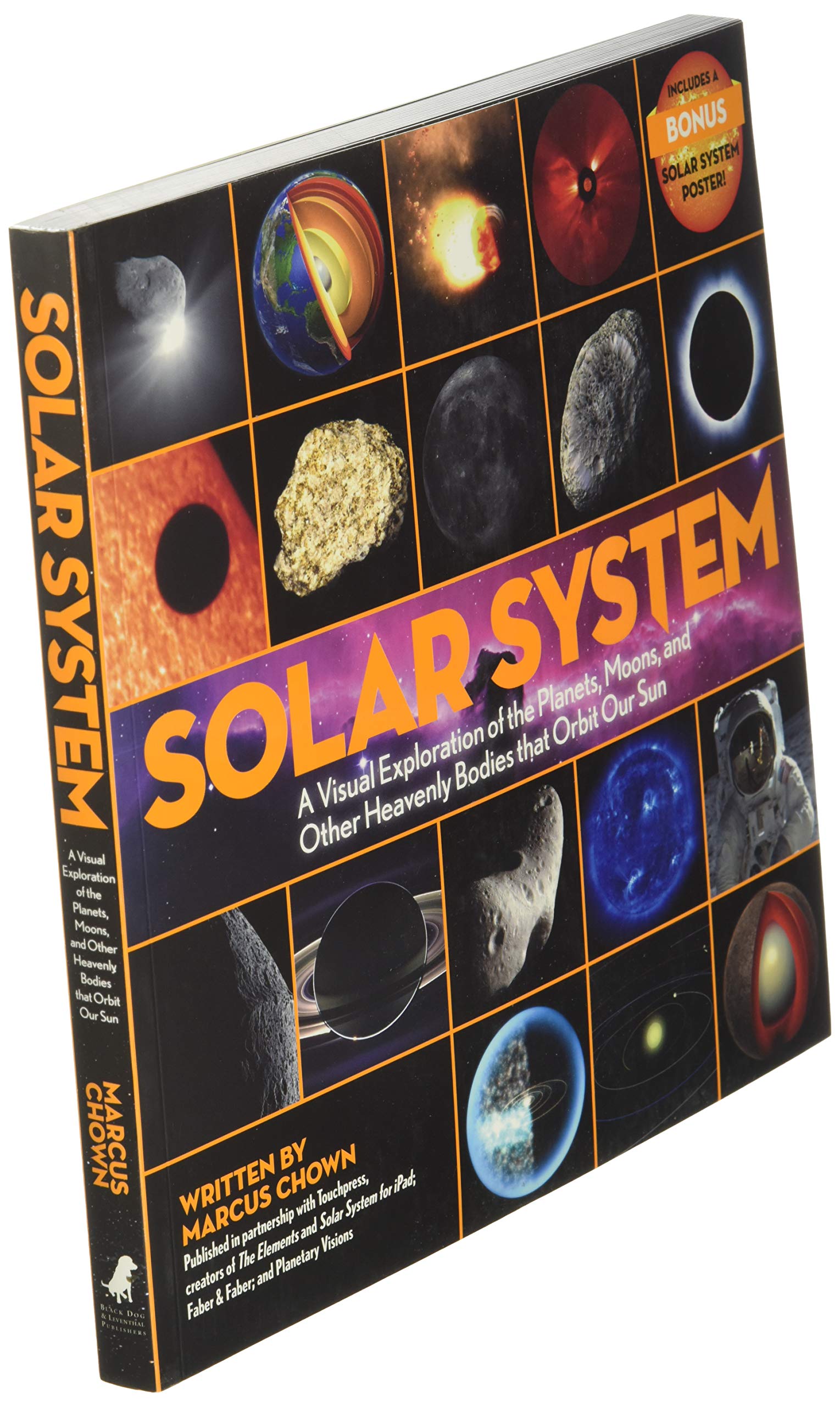Customer Services
Copyright © 2025 Desertcart Holdings Limited
Desert Online General Trading LLC
Dubai, United Arab Emirates






Full description not available
B**K
An Educational Visual Treat
Solar System: A Visual Exploration of the Planets, Moons, and Other Heavenly Bodies that Orbit Our Sun by Marcus Chown"Solar System" is the visually stunning book about our solar system. This perfect coffee table book is adorned with hundreds of striking high quality images and graphics and complimented with fascinating facts. Award-winning author and former astronomer Marcus Chown provides the words behind the pictures and educates the public on the awe-inspiring wonders of our Solar System. This elegant 224- page book covers the planets, moons, asteroids, dwarf planets and other components of our Solar System.Positives:1. An absolute visual treat. High quality photos on high-quality binding does this dazzling book justice.2. An accessible book for the masses. A great book for all ages.3. A great format for a book of this kind. The author provides a topical narrative and a fact sheet on the right hand of the page. The fact sheet is basically a "vital statistics" of each astronomical body. Providing information such as: size, mass, surface temperature, mean density, maps, etc...Great stuff!4. The book was published in late 2011 so it's current.5. Not only is the book visually stimulating it is quite enlightening too. The author inserts interesting topics throughout the book. Einstein vs. Newton as an example.6. Interesting tidbits throughout, like how to spot of a planet.7. Every planet is obviously covered but each planets most significant moons too and some are quite fascinating.8. This is the kind of book that can satisfy the curiosity of a child. As a child, I loved reading my Encyclopedia this may have the same effect on your children.9. Great topics, is there life on Mars?10. The Asteroid Belt. Killer asteroids.11. The planet that never was.12. The fascinating moon of Europa!13. The safest moon to travel to is...14. The mesmerizing rings of Saturn. Interesting stuff!15. The most stunning rock bodies of our Solar System.16. The mystery of the missing moon.17. Dark matter...enlighten me.18. The Kuiper Belt.19. Dwarf planets.20. The Oort Clouds and how we know it even exists.21. Comets!Negatives:1. If you are looking for an in-depth book about astronomy look elsewhere.2. No notes, references, bibliography or even web links to speak of.3. The metric system is used which is common in physics to do so.4. A section on space ships would have added value.5. A glossary of terms never hurts.In summary, this is the perfect coffee table top book about our solar system. I was looking for the perfect book to adorn my living room table top and I absolutely found it in this gem. The high-quality pictures are absolutely stunning and the author does a wonderful job of providing concise and lucid words to describe the photos and graphs illustrated. This is the perfect book to give as a gift as it will provide hours of visual fun while enlightening the reader on the basics of astronomy. If you are looking for a visual astronomical treat to put on your table, you won't do much better than this book. A high recommendation.Recommendations: "Space Chronicles: Facing the Ultimate Frontier" by Neil deGrasse Tyson, "About Time: Cosmology and Culture at the Twilight of the Big Bang" by Adam Frank, "Death from the Skies!: These Are the Ways the World Will End . . ." and "Bad Astronomy: Misconceptions and Misuses Revealed, from Astrology to the Moon Landing "Hoax"" by Philip Plait, "Wonders of the Universe" by Brian Cox, and "Cosmos" Carl Sagan.
C**E
Another beautiful book by the creators of The Elements by Theodore Gray
"Solar System" exhaustively describes the components of our solar system, starting with a general overview of its explosive origins, then moving on to the description of the sun and of the other celestial bodies. Included are the planets, beginning with Mercury - the closest body to the sun - on to Venus, the Earth, Mars, etc. and their satellites, (for those who do have satellites). Also covered are the components of the Asteroid Belt, the components of the Kuiper Belt, Pluto, the dwarf planets, the Oort cloud and the comets.The illustrations include images of the planets and their orbits, planet and moon globes, cross sections showing the interior structure of the sun, of each planet and some satellites, planet and moon maps, scale maps (size of each celestial body as compared to a familiar object, ranging in size from the earth down a human being), as well as separate photographs of the same planets, the satellites, etc. They are by far the best part of the book for several reasons: (1) Many of them are original photographs collected by space probes over the past thirty years. These are actually of such high quality that they could very well be the next best thing to the direct observation. (2) They are abundant and wide-ranging, sufficiently so that they could almost describe the subject without the help of the accompanying text. (3) They are attractive. In addition to being in color with well-defined details, the various celestial bodies are presented against a black background, which contributes to the sensation that we are observing objects originating from outer space. (4) They extend in scale from whole disc images taken by ground based or space telescopes, to microscopic views of rock structures. (5) They were taken by using the entire spectrum of sensors available to probe planetary surfaces, atmospheres and magnetic fields, thus including, photographs taken within the wavelength ranges of visible, ultraviolet and infrared light, and also of x-rays and radio emissions.The text - particularly when compared to the quality of the photographs - is somewhat disappointing, particularly so at the beginning, as it consists of often shorter poorly descriptive paragraphs . The white against a black background (a plus when dealing with the photographs) makes it sometimes difficult to read.Still, once we accept that the quality of the photos is difficult to match, the information provided by the text is more than sufficient. Included are descriptions of: (1) the Orbital Data (distance from the sun or planet - when describing the satellites, orbital period, length of day, orbital speed, orbital eccentricity, orbital inclination, axial tilt); (2) the Physical Data (diameter, mass, volume, gravity, escape velocity, surface temperature, mean density); (3) the Atmospheric Composition.Inaccuracies are few and minor. For example, on page 115, under Physical Data, Jupiter has two mean densities, 0.690 g/cm3 and 1.33 g/cm3.Spelling errors are also few. Worth mentioning - as a recurrent inaccuracy - is that "Orbital Inclination" under Orbital Data in the title section of each planet/satellite is spelled correctly when describing Mercury, Phobos and Deimos. It is printed as Orbit Incination for all the other planets and celestial bodies.Despite the relatively poor text - when compared to the images - and the very minor inaccuracies, this is a beautiful book. My knowledge about astronomy has always been reasonably extensive for an amateur. But I have acquired a considerable amount of additional information by reading the "Solar System". The ease of presentation, along with the many illustrations, make the process of learning dramatically easier. I could not put the book down and was sorry when I reached the end.
A**R
Good visuals
I am using this book with my 8 yr old grandson who is doing online learning this year. He very much likes the visuals and charts. Even his granddad is learning things about the solar system.
M**S
Excellent book
Excellent up-to date presentation of many different subjects that are well fit for school assignments and interesting discussion with kids!
M**A
Good quality, delivery on time
Good quality, delivery on time
Y**E
Up-to -date, full of relevant pictures
A must-have to get the last news from the Solar System. Many explanations are offered and I particularly appreciate the quality of the pictures. For each objets, orbital data, physical data and atmospheric conditions are given.
D**M
Five Stars
A clear description of our solar system, very well illustrated.
Trustpilot
1 month ago
3 weeks ago
2 weeks ago
2 weeks ago